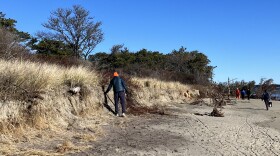A new study led by the Maine Center for Disease Control sheds some light on how harmful PFAS chemicals move from the soil into crops used as livestock feed. Researchers hope it will help farmers manage grazing to reduce the risk of contamination.
One of the key findings is that as farmers made multiple cuts of hay or grass during a single season, PFAS levels in those crops tended to be higher in the second or third cuts.
Tom Simones, assistant state toxicologist at the CDC and lead author of the study, said beef farmers could feed their cattle first cut hay to lower the risk of contamination.
"So just before going to market, there could be a period of time where they're getting feed with low or no levels of PFAs, so they can still use all of their feeds as kind of a management strategy," he said.
He said the research will also help the state better advise farmers on crop rotation.
"For those fields with higher [PFAS] soil levels, they could switch to a different crop, such as corn, that takes up less PFAS than grass," Simones said. "Then use that as their feed source from that field."
He said the team also found PFAS levels varied widely even among fields on the same farm, and that more research is needed to understand why.
Simones said this research is significant because there is very little existing scientific literature on how PFAS chemicals move through agricultural systems.





